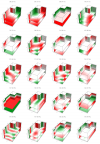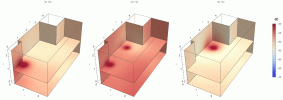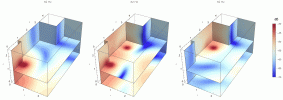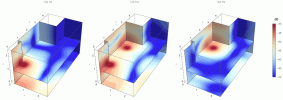2.0 I believe.Which Dirac version do you use as the newer 3.x are supposed to have better bass handling?
-
WANTED: Happy members who like to discuss audio and other topics related to our interest. Desire to learn and share knowledge of science required. There are many reviews of audio hardware and expert members to help answer your questions. Click here to have your audio equipment measured for free!
You are using an out of date browser. It may not display this or other websites correctly.
You should upgrade or use an alternative browser.
You should upgrade or use an alternative browser.
Bass arriving out of phase at the listening position
- Thread starter edechamps
- Start date
- Joined
- Jun 5, 2020
- Messages
- 4,800
- Likes
- 3,744
Guys...room modes, especially overlapping ones, are not going to be modified much by adjusting the speakers. It's all about the seated location now. Since he can't move that without a major rethink of the setup, the best solution is front and rear subs.
- Joined
- Jan 15, 2020
- Messages
- 6,873
- Likes
- 16,838
I think you can freely update to the current 3.x? In that case your findings would be very interesting.2.0 I believe.
- Thread Starter
- #44
I mean the TV.
Ah. Interesting idea. The TV is on stands and it does wobble when disturbed, so I guess it could conceivably resonate in some way. I'll see if I can find a way to remove the TV from the equation as an experiment. I should be able to remove it from the room since it's on casters, but it's still a massive 40 kg 77" TV so not exactly a piece of cake.
It's all about the seated location now.
As I showed in this post, moving the listening position by as much as 1.4 meter in any direction does not really get rid of the problem. (I'm as surprised as you are.)
I was wondering what if I compute the summation of all possible combination of all 4 speakers (including rear speakers), just to see which combinations show the problem and which don't. (Note that I made sure to introduce delays to time align all speakers before measuring.) Here's the result:
This is… intriguing:
- Good: Front Right + Back Left, Front Right + Back Right, Back Left + Back Right
- Kinda bad: Front Left + Back Left, Front Left + Back Right
- Really bad: Front Left + Front Right
This seems to suggest that all speakers agree on phase except Front Left which is the one causing trouble… Incidentally, it's also on the front left channel that excess group delay is the highest, peaking at 26 ms at 86 Hz.
Last edited:
Sokel
Master Contributor
- Joined
- Sep 8, 2021
- Messages
- 6,038
- Likes
- 6,058
If you consider that fiber glass bass traps are not much bigger (don't know the density of the TV though) it will sure have have effect.Ah. Interesting idea. The TV is on stands and it does wobble when disturbed, so I guess it could conceivably resonate in some way. I'll see if I can find a way to remove the TV from the equation as an experiment. I should be able to remove it from the room since it's on casters, but it's still a massive 40 kg 77" TV so not exactly a piece of cake.
- Joined
- Jun 5, 2020
- Messages
- 4,800
- Likes
- 3,744
So the path is clear: spin that desk around!Ah. Interesting idea. The TV is on stands and it does wobble when disturbed, so I guess it could conceivably resonate in some way. I'll see if I can find a way to remove the TV from the equation as an experiment. I should be able to remove it from the room since it's on casters, but it's still a massive 40 kg 77" TV so not exactly a piece of cake.
As I showed in this post, moving the listening position by as much as 1.4 meter in any direction does not really get rid of the problem. (I'm as surprised as you are.)
I was wondering what if I compute the summation of all possible combination of all 4 speakers (including rear speakers), just to see which combinations show the problem and which don't. (Note that I made sure to introduce delays to time align all speakers before measuring.) Here's the result:
View attachment 231742
This is… intriguing:
- Good: Front Right + Back Left, Front Right + Back Right, Back Left + Back Right
- Kinda bad: Front Left + Back Left, Front Left + Back Right
- Really bad: Front Left + Front Right
This seems to suggest that all speakers agree on phase except Front Left which is the one causing trouble… Incidentally, it's also on the front left channel that excess group delay is the highest, peaking at 26 ms at 86 Hz.
I experimented with numerical simulations, with my guesses of your room dimensions and speaker locations. Curious to see if the simulation results have any resemblance to what is actually happening with your room. I used a uniform 0.2 absorbance for all room boundaries (i.e. walls, ceiling and floor). Results does seem to show the huge null in the listening position, but does not show a lower SPL when both speakers are playing vs only one.
Here are the room modes.

Here are the in-room response simulations of left, both, and right speakers playing. I have to break-up the animated GIFs due to file size restrictions. These simulations do take a bit of time to compute (about 1.5 hours, largely due to the inefficiency of Mathematica in generating plots) with my laptop (6 core i7-10750H).



Here are the room modes.

Here are the in-room response simulations of left, both, and right speakers playing. I have to break-up the animated GIFs due to file size restrictions. These simulations do take a bit of time to compute (about 1.5 hours, largely due to the inefficiency of Mathematica in generating plots) with my laptop (6 core i7-10750H).



Is it possible to export an impulse file from this model?I experimented with numerical simulations,
- Thread Starter
- #50
Wow @NTK, that's quite impressive, thanks! You should have asked me for the precise dimensions - I have reasonably accurate floorplans and a rough idea of what the walls are made of.
Is there any way I can reproduce your simulation and do some simulated experiments myself? I've always wanted to do stuff like this but have no idea where to start. Can you provide some pointers? I'm a software engineer so coding is not a problem, I've done some limited scientific/numerical work before (Matlab/numpy), and I'm willing to spend the time to understand how to do this. I'd appreciate any opportunities to extend my skills in that area. My main problem is that I don't have a strong physics background.
One thing I'm considering doing is taking many FR measurements at many points in space within the room so that I can visualize the changes in response across the 3D space. The idea is that any spatial "patterns" that come out could help determine the root cause. That would be a project in and of itself though.
Is there any way I can reproduce your simulation and do some simulated experiments myself? I've always wanted to do stuff like this but have no idea where to start. Can you provide some pointers? I'm a software engineer so coding is not a problem, I've done some limited scientific/numerical work before (Matlab/numpy), and I'm willing to spend the time to understand how to do this. I'd appreciate any opportunities to extend my skills in that area. My main problem is that I don't have a strong physics background.
One thing I'm considering doing is taking many FR measurements at many points in space within the room so that I can visualize the changes in response across the 3D space. The idea is that any spatial "patterns" that come out could help determine the root cause. That would be a project in and of itself though.
I currently use Mathematica, and have a couple of threads on the methods.

 www.audiosciencereview.com
www.audiosciencereview.com

 www.audiosciencereview.com
www.audiosciencereview.com
Doing it in Mathematica is quite troublesome IMHO. It isn't easy/convenient to define the geometry and to plot the results. I use it more for prototyping and for my own fun and learning purposes. I have been looking into other open source and free tools, and think a combination of OpenSCAD (for building the 3D room model), GMSH (for mesh generation), FEniCS (for the numerical problem solving), and ParaView (for visualization) may do the job. The project will take a fair amount of time and effort, and I am hoping in the end we may be able to come up with a container that is usable by other "enthusiasts".

Arbitrary Shape Room Mode Simulator
This opening post is to show how to simulate room modes using Mathematica. The other room mode calculators I could find on the web can only handle rectangular box shaped rooms. Mathematica can solve for arbitrarily shaped room. I only attempted 2D, but theoretically Mathematica should be able to...
 www.audiosciencereview.com
www.audiosciencereview.com

In-Room Speaker Frequency Response Simulation (Low Frequency)
[Edit] Member edechamps has pointed out my method of modeling wall absorption was incorrect and he is right. I have replaced the attached ZIP archive with update the Mathematica and Jupyter notebooks. With the old method, the wall absorption was much higher than they should be, and the updated...
 www.audiosciencereview.com
www.audiosciencereview.com
Doing it in Mathematica is quite troublesome IMHO. It isn't easy/convenient to define the geometry and to plot the results. I use it more for prototyping and for my own fun and learning purposes. I have been looking into other open source and free tools, and think a combination of OpenSCAD (for building the 3D room model), GMSH (for mesh generation), FEniCS (for the numerical problem solving), and ParaView (for visualization) may do the job. The project will take a fair amount of time and effort, and I am hoping in the end we may be able to come up with a container that is usable by other "enthusiasts".
Maybe hire an acoustician?So riddle me this:
View attachment 231557
The above graph shows the response at my listening position from my left speaker (red), right speaker (green) as well as the response of both playing at the same time (blue). All graphs use 1/12 octave smoothing for readability.
Ignore the large null on the right channel at 112 Hz - that's not what I want to talk about. (Yes, it's a problem, but not one I've been able to solve thus far.)
What's driving me nuts is the summation - or lack thereof - between the left and right speakers around 90 Hz.
Mathematically, this can only be explained by the sound arriving at the listening position out of phase between the left and right channels. And indeed:
View attachment 231561
View attachment 231562
There is a whopping 187° difference between the left and right channels at 90 Hz. (Note: these measurements were made using the REW acoustic timing reference feature to ensure this comparison is valid.)
Computing the vector vs. RMS average of the two channels yields a result that should come as no surprise at this point:
View attachment 231564
And if we compute the difference between the two, we can see that this problem results in an eye-popping 6-12 dB destructive interference between the two channels across an entire octave:
View attachment 231565
This leaves me somewhat flabbergasted. I've calibrated quite a few systems before, and I've never seen bass frequencies get out of phase like this. I just assumed there was some kind of physical law that somehow guaranteed that, as long as the speakers were at equal distance/delay (and in this case they are), in a typical room, bass frequencies would be in phase and would sum constructively. I guess that means my room is atypical in a particularly weird way…
This is a big problem because I'd expect most recordings to assume coherent bass summation, but that's not the case in this system.
I have no idea what's causing this in this particular room. I've tried various experiments (including covering an entire wall with bass traps) with no success. Sometimes I manage to change the responses of the left and right channels somewhat, but no matter what I do, they always stay out of phase.
The only solution I could find was to work around the issue using EQ allpass filters to restore proper phase - so that, after EQ, the summed response is consistent with the response of left and right channels. That works, but obviously a lot of finesse is required in designing the EQ filters. Someone who only has access to "basic" PEQ or doesn't know how to manipulate phase using allpass filters would have no chance of getting this right. They would have to make a carnelian choice between having a correct response when individual channels are playing, or the correct response when both channels are playing. And that's assuming they even spot the problem in the first place. I really hope my case is some kind of isolated extreme scenario - if it's not, then I guess we'll have to revise standard calibration procedures!
I'm not quite sure what I'm hoping to get out of this thread, but I guess it could serve as a warning to watch out for this problem. Obviously, if anyone has any theories or possible acoustical solutions (besides manipulating phase via EQ which is what I'm already doing), please shout!
Additional information
Pictures of the audio system, room and listening position:
View attachment 231568 View attachment 231569 View attachment 231570
The speakers are Genelec 8030As. The squares/rectangles on the walls are RealTraps Fat MondoTraps. (They were positioned for optimal frequency response as empirically determined through measurements.)
Before you ask:
- Did you try removing/moving the bass traps or the desk? Yes. It doesn't make any difference. It changes the responses somewhat but they are still out of phase by a similar amount.
- Are you sure one speaker is not wired out of phase? Yes. Also it would be extremely obvious in the above graphs if that was the case. The sound is only out of phase between 60-120 Hz, not elsewhere.
- Are you sure it's not a problem with one of the speakers? Yes. I checked for that by swapping the front pair for the rear pair. The results are exactly the same.
- Are you sure it's not the DAC/some DSP/etc.? Yes. I tried a different DAC and cable. The results are exactly the same.
- Did you try moving the speakers or the listening position? No, because unfortunately I can't really do that. As you can see on the pictures it's a small room and the current layout is the only one that's practical.
- Maybe you can work around the problem by crossing the sub above the problematic region? I tried that, but I have to cross the sub so high (~110 Hz) that it becomes audibly localizable and the sound stage gets pulled towards the sub, which is located in the front left corner to avoid room modes.
- Maybe a cardoid bass speaker like the Dutch & Dutch 8C could help? Maybe. I'm sceptical because even the D&D 8C is still omnidirectional at 90 Hz. The Kii Three seems to fare a bit better, maybe it's worth a try, I don't know. Given how much these speakers cost it's quite the risky bet!
Yes. Please let me know of your room dimensions and speaker positions, and I will let my computer churn some graphs out. I am very interested to see if this type of simulations are useful (good enough) in helping with this type of problems.Wow @NTK, that's quite impressive, thanks! You should have asked me for the precise dimensions - I have reasonably accurate floorplans and a rough idea of what the walls are made of.
Yes; I expect geometric reasons.Curious to see if the simulation results have any resemblance to what is actually happening
Asymmetric absorbtion in REW does not cause asymmetric results:
Hipper
Addicted to Fun and Learning
I've not used Real Traps Mondo Bass Traps but get the impression that if you want to get the best performance at the lowest frequencies you should place them across a corner rather then flat against it. If you look at the Mondo Measurement page and compare results for 'Mondo Trap in Corner' and 'Mondo Trap on Wall' - note the difference in the 90Hz region.
https://realtraps.com/data.htm
If you haven't already done this in your experiments it might be worth a try. Place one on top of the other in each of the four corners as best you can, covering the full height of the wall if it's practical. For bass trapping, these are the most important positions. Other corners, such as wall-ceiling and wall-floor are also useful but more awkward to achieve.
The other obvious question is - do you actually hear the problem?
You could check this out by using Real Traps Test Tone CD:
https://realtraps.com/test-cd.htm
https://realtraps.com/data.htm
If you haven't already done this in your experiments it might be worth a try. Place one on top of the other in each of the four corners as best you can, covering the full height of the wall if it's practical. For bass trapping, these are the most important positions. Other corners, such as wall-ceiling and wall-floor are also useful but more awkward to achieve.
The other obvious question is - do you actually hear the problem?
You could check this out by using Real Traps Test Tone CD:
https://realtraps.com/test-cd.htm
Vuki
Senior Member
here is a bit more about it Acourate forum thread
allpass filter could help
allpass filter could help
- Thread Starter
- #57
Yes. Please let me know of your room dimensions and speaker positions, and I will let my computer churn some graphs out. I am very interested to see if this type of simulations are useful (good enough) in helping with this type of problems.
Very well then. You don't need to ask me twice
Here's the floorplan with a bunch of dimensions I added for your convenience:
The distance from listening position to each front speaker is 1.8m.
The ceiling height is 2.33m in the "entrance" to the room and becomes 2.54m in the main "square" once you get past the wardrobe. The ceiling is made of drywall held by a steel mesh, with a ceiling void above it.
This is what the internal walls are made of:
I don't know about the external wall. Also I suspect the thick portion of wall in the upper right corner is made of a load bearing pillar of steel-reinforced concrete behind the drywall. (I always had my doubts about that pillar - I suspect it's extremely reflective which might contribute to the problem, given it's right behind the offending front left speaker.)
The window is floor-to-ceiling and is double-glazed with an airtight seal.
I also attach a zipfile that contains the floorplans as a vector PDF, and also the original Microsoft Visio file which (if you happen to have Visio at hand) can be used to add more annotations.
Attachments
Last edited:
I suspect moving the mic 70 cm right will be in about the middle of the 4,63 width of the room, causing a standing wave dip at around 80 Hz?More experiments with moving the speakers or microphone: (this is vector sum relative to rms sum)
View attachment 231719
As you can see, even if I move stuff around (which is not a viable solution in practice, anyway), it's all pretty much crap.
Placing the speakers on the floor doesn't really solve anything either, which makes me pessimistic about the idea of using subs placed on the floor close to the mains to work around the problem.
I guess one option I haven't considered is to replace the bass traps with tuned bass traps specifically designed to fight these problematic frequencies. But I'm reluctant to go through the hassle given I have no idea if it would actually work…
@edechamps
Can you post a waterfall or a spectrogram?
Can you post a waterfall or a spectrogram?
I am not going to model the acoustic panels and just use one estimated absorption coefficient for the entire room (at least for the time being). They are a PITA to model and specify in Mathematica. Can you also give me your speakers and listening (ear) heights?Very well then. You don't need to ask me twiceI'm also quite curious to see what is possible with simulation. If we can just let the computer figure it out, solving these problems would be sooo much easier… I'll take a look at the threads you linked.
Here's the floorplan with a bunch of dimensions I added for your convenience:
View attachment 231802
The distance from listening position to each front speaker is 1.8m.
The ceiling height is 2.33m in the "entrance" to the room and becomes 2.54m in the main "square" once you get past the wardrobe. The ceiling is made of drywall held by a steel mesh, with a ceiling void above it.
This is what the internal walls are made of:
View attachment 231807
I don't know about the external wall. Also I suspect the thick portion of wall in the upper right corner is made of a load bearing pillar of steel-reinforced concrete behind the drywall. (I always had my doubts about that pillar - I suspect it's extremely reflective which might contribute to the problem, given it's right behind the offending front left speaker.)
The window is floor-to-ceiling and is double-glazed with an airtight seal.
I also attach a zipfile that contains the floorplans as a vector PDF, and also the original Microsoft Visio file which (if you happen to have Visio at hand) can be used to add more annotations.
Thanks.
Similar threads
- Replies
- 9
- Views
- 947
- Replies
- 39
- Views
- 3K
- Replies
- 7
- Views
- 983
- Replies
- 5
- Views
- 639
